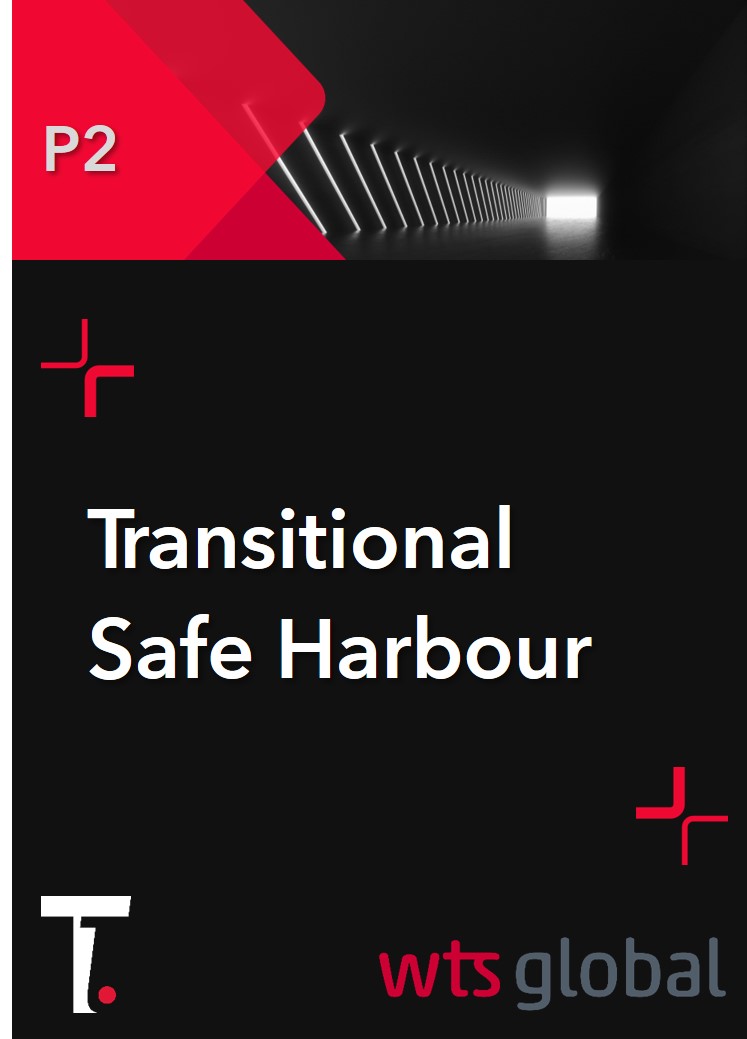As mentioned in our newsflash of 13 December 2020, we expected the OECD to issue further information on the safe harbors before or around the holidays season. For further clarifications, as part of the Administrative Guidelines, we now understand that we have to wait until early 2023.
Full current guidance can be consulted here. For those of you, who want to be informed on the key elements of the transitional and potential permanent safe harbours, but have (undoubtedly rightfully) more important things to cherish the coming weeks, please find here one-page summary overviews of the three topics, at a glance.
In the remainder of this article, we will provide you with our views, and try to answer the question raised in the title – Does this guidance really solve key practical issues, or is it just a drop in the ocean?
To answer this question several aspects should be taken into consideration. Some are, at first sight, positive and others appear less positive. It should be taken into consideration that the safe harbors de facto strive for a proportionate balance between the ‘risk’ tax administrations will want to manage by introducing the GloBE rules and the difficulties MNE’s will undoubtedly face on a relatively short notice regarding the compliance and other burdens that Pillar Two brings with it.
In the box below, we first highlight the elements of the guidance that in our view contribute positively, followed by elements that in our appreciation are missing, could have been done better… not to say, that are negative in our view. Finally, we present our conclusions.
Positive elements
- The mere fact that the Inclusive Framework issues this guidance on transitional and permanent safe harbours transitional penalty relief regimes, is already a very positive element. It demonstrates its sensitivity (to a certain extent) to the comments that have been made by stakeholders, in particular the MNEs themselves..
- The Transitional CbCR Safe harbours are quite detailed and conclusive, giving less opportunity for ambiguity when implemented in domestic laws in the various countries.
- Furthermore, the duration of the transition period (generally, until and including the fiscal year that begins on or before 31/12/2026) in our appreciation seems fair for MNEs to prepare for the full set of GloBE rules (provided that the permanent Simplified Calculations Safe Harbour applies).
- The (De Minimis, ETR and Routine Profits) tests for assessing eligibility to apply the Transitional CbCR Safe Harbours, indeed represent (in various degrees, as ranked here, from highest to lowest) a meaningful simplification in terms of organizing data availability and adjustments required, in particular for MNEs that already have a good process in place for CBCR.
- Notwithstanding the fact that the simplified calculation base purposefully differs from the GloBE rules for the De Minimis test under the Transitional CbCR Safe Harbour, the guidance retains the thresholds of the general GloBE rules, and does not seek to establish a trade-off between stricter thresholds and the more relaxed source of information and calculation basis.
- Notwithstanding the fact that the simplified calculation base purposefully differs from the GloBE rules for the ETR test under the Transitional CbCR Safe Harbour, the guidance does not set the bar of the Transition Rate insurmountably high (exactly 15% for 2023 and 2024, and increasing only to 16% and 17% for 2025, resp. 2026) to create a buffer on ETR.
- Overall, the fact that the report contains justification statements and clarifies that the Transitional CbCR Safe Harbour does not undermine the integrity of the GloBE rules, can be considered very useful and important.
- The permanent Simplified Calculations Safe Harbour framework includes the same testing approaches as the Transitional CbCR Safe Harbour rules which in that sense provides for clarity in approach. The framework calls rightfully for an implementation of these Safe Harbours while maintaining the integrity of the GloBE rules which is consistent with the purpose of the Transitional CbCR Safe Harbour rules.
- In respect of the ETR test under the permanent Simplified Calculations Safe Harbour, the guidance keeps the threshold rate at exactly 15%, and accordingly no buffer is deemed to be necessary in this respect.
- In view of the Simplified Calculations Safe Harbour framework for Non-Material Constituent Entities (NMCEs) specifically, the guidance is more detailed and conclusive in view of simplification measures.
- Overall, the Simplified Calculations Safe Harbour (currently) do not contain broad exclusions, but a few specific ones.
- In view of the Transitional Penalty Relief Regime, avoiding the application of penalties for non-compliance by demonstrating having taken “reasonable measures” is to be considered an appropriate standard.
- Furthermore, the duration of the transition period (generally, until the fiscal year that begins at the latest per 31/12/2026) in our appreciation seems fair for MNEs to prepare for full compliance when the full set of GloBE rules to apply in full (provided the permanent Simplified Calculation Safe Harbour would apply and be effective).
Negative elements
- In respect of the Transitional CbCR Safe Harbour a few technical remarks could be considered to further improve the safe harbour tests (as we understand that the Inclusive Framework may further supplement this guidance):
*Notwithstanding using current year data only limits the amount of data sources to be used, it risks to penalize MNEs that have an exceptional result in any given year (certainly in view of the “once out, always out” approach (cf. further below). In sync with the final GloBE rules, it may therefore be more appropriate to consider a 3 year average of (simplified) data to be sourced - Or, let MNEs elect (once).
*The Inclusive Framework could have considered to set the thresholds for the De Minimis test higher in the initial phase of the Transitional Period, whilst converging to the level presented now over the course of the Transition Period (but such potential improvement does not erase the fact that the principle in itself is warmly welcomed); and
*The Inclusive Framework could have considered to set the thresholds for the ETR test invariably at 15% considering that the integrity of the GloBE rules is rightfully assumed to not be undermined (but also in this regard, the mere fact that the thresholds are set as they are, is in itself definitely to be considered a positive development). - More importantly, and from a technical perspective also with reference to our earlier remark on the potential downside of being able to use only current year data, we find the “once out, always out” approach to the Transitional CbCR Safe Harbour remarkable. The added value of this limitation is unclear. Under the assumption that the Inclusive Framework still has the opportunity to fine-tune this guidance, we would suggest to rethink this “once out, always out” exclusion and/or at least provide for an optional averaging opportunity.
- Overall, the exclusion grounds for not being eligible to apply the Transitional CbCR Safe Harbour are too many in the current guidance in our view. Most importantly, the exclusion of the multi-parented MNE Groups where a single Qualified CbC Report does not include the information of the combined groups seems somewhat excessive. Since it is solely based on a mere fact of legal structure which is in principle driven by business reasons, rather than intrinsically being a red flag for aggressive tax planning. Certainly in view of the fact that e.g. for JV’s and for Non Material Constituent Entities, alternative data sources can be used for Safe Harbour purposes. It could be suggested that such multi-parented MNE Groups would also be allowed to extract data from the financial accounts, but in a manner that is equally consistent with the definitions of CBCR regulations (notwithstanding that for CBC regulations itself they are not reported as such in the CBCR itself). Allowing such (one-time) election would in our view not undermine the essence of the GloBE rules, and by having a positive election system, the tax administration reviewing the data can easily identify the cases that require specific attention.
- Finally, a very important issue which has not been treated in the Transitional CbCR Safe Harbour is that of allowing a transitional period for MNE Groups that are becoming first-time Pillar Two adopters in a later stage. Indeed, depending on the timing of them reaching the thresholds to fall within scope of Pillar Two, they might have access to the Transitional CbCR Safe Harbour for only a limited period of time, or even not at all. Where such MNE groups would be confronted with CbCR compliance for the first time, and at almost the same time also the complex Pillar Two requirements, it can be expected that some kind of transition period and therefore Transitional Safe Harbours could not only be welcomed, but logical as well. Where such MNE Groups are on a (rapid) growth track, they may have a different business focus, and (in our experience) sometimes are at risk of not having an HQ organization that is yet mature enough to have the necessary tax control framework, IT and other processes, people and systems available at short enough notice. The Inclusive Framework could therefore be encouraged to foresee in supplementary guidelines for such MNE groups in line with the current Transitional CbCR Safe Harbour and this for a similar transition period of a limited number of years.
- As regards the permanent Simplified Calculations Safe Harbour framework the key negative element is that it is only a potential safe harbour. Indeed, no agreement has been reached within the Inclusive Framework (yet). Currently and disappointingly, the relevance of the depicted permanent Simplified Calculations Safe Harbour is therefore very low, if relevant at all. It is therefore, in our view, non-guidance, which is disappointing at a time that the GloBE rules are to be enacted in domestic laws very soon.
- Perhaps an overly simplistic logic, but we wonder why a transitional safe harbour that is substantiated by the Inclusive Framework as not undermining the integrity of the GloBE rules could not be considered as not undermining the GloBE rules in a permanent manner as well. Overall, the GloBE rules could be perceived as overly mechanical and complex (for what largely will be a compliance burden for MNEs), and perhaps the solution in our view may lie in a simple and practical approach .
*Specifically in view of the permanent ETR test, we could see the transitional ETR test being used as a permanent ETR test, where additional comfort could potentially come from a higher ETR threshold to act as a buffer – e.g. 17 or 18% after the transition period.
*Considering that the De Minimis thresholds for MNE Groups already represent a maximum proportion of 1.33% in revenues and 0.13% in profit margin, we are of the view that those should not be further lowered to comfortably change the traditional De Minimis test into a permanent De Minimis test.
*And, in view of the Routine Profit test, potentially, the stretch made under the NMCE specific guidance – I.e. having a broad interpretation of the GloBE Income proxy and a narrow interpretation for the GloBE Adjusted Taxes proxy in the full SBIE comparison – could work as a general permanent safe harbour as well. - We understand that the details for the Permanent Safe Harbour framework are still to be developed under a so-called Agreed Administrative Guidance, and that the Inclusive Framework would proceed with this work. One can hope that the Inclusive Framework makes good progress in this regard, in order to safeguard a globally as consistent as possible set of rules, for in the current safe harbours document of 20 December 2022, reference is made to a “degree of flexibility” for individual countries. Therefore, it is difficult to feel quite positive or optimistic about the Permanent Safe Harbour in its current state, form and status solving real issues.
- Finally, with respect to the transitional Penalty Relief regime the conclusion may be short: The proof of the pudding will be in the eating.
- Consistent with our earlier remark, we strongly suggest a similar Transitional Penalty Relief Regime for MNE Groups that are becoming first-time Pillar Two adopters at a moment beyond the go-live of the GloBE rules.
Our conclusions:
- Most importantly, we value the positive elements more than the negative elements in view of the Transitional CbCR Safe Harbour, and we believe they indeed may provide for a genuine, temporary reduction of the burden – albeit this will vary greatly according to the MNEs level of centralization and overall readiness in view of people, processes and systems; Nevertheless, we think a few technical refinements are strongly recommendable, (either as a review of the monitoring process, or supplementary guidance) most notably:
- Not imposing a “once out, always out” rule and/or giving MNEs the option to elect for a current year vs. a 3-year averaging approach
- Review the many grounds for being excluded from this transitional safe harbor, especially providing for an alternative, reasonable approach for Multi-Parented MNE Groups – if needed with some additional reporting for providing transparency in the applied alternative.
- Provide for similar or even better the same (by making abstraction of hard coded fiscal years, but make reference to first fiscal year, second fiscal year, and so on…) Transactional CbCR Safe Harbour for MNE Groups that are becoming first-time Pillar Two adopters at a moment beyond the go-live of the GloBE rules.
- In stark contrast to our largely positive feelings in view of the transitional safe harbours, as regards the permanent Simplified Calculation Safe Harbour we can be very short: We are deeply disappointed by the de facto non-guidance provided at this stage considering that the effective date of the far-reaching GloBE regulations is approaching very fast made, and the transitional safe harbour may not conver every situation.
- Finally, in view of the Transitional Penalty Relief Regime, we find this guidance obviously very welcome, but strongly recommend to not forget MNEs that have to adopt Pillar Two for the first time at a later stage.
Overall, we advise MNEs to keep calm and await the further administrative guidance of early 2023 that should (we hope) contain further clarifications from a GloBE rules content perspective (albeit sure that some uncertainties and difficulties will remain). On that basis it can then be assessed appropriately on a case by case basis whether it makes sense to strive for the application of the Transitional Safe Harbours or just get on with the full pack in view of the prioritization of your scarce resources.
Please note that part of this article contains viewpoints and opinions of the authors that are not necessarily the same as the viewpoints and opinions of Tiberghien or WTS Global. The authors can be contacted at: andy.neuteleers@tiberghien.com and rik.smet@tiberghien.com.
1 Next to the guidance discussed in this article, the OECD released two public consultation documents in respect of Pillar Two: one on the GloBE Information Return and one on Tax Certainty.
For further enquiries on Pillar Two topics, please reach out to any of our team members:
Bart De Cock – Partner (Belgium) – bart.decock@tiberghien.com
Robin Minjauw – Partner (Belgium) – robin.minjauw@tiberghien.com
Koen Morbée – Partner (Belgium) – koen.morbee@tiberghien.com
Andy Neuteleers – Partner Tiberghien economics (Belgium) – andy.neuteleers@tiberghien.com
Ahmed El Jilali – Counsel (Belgium) – ahmed.eljilali@tiberghien.com
Rik Smet – Senior Associate (Belgium) – (rik.smet@tiberghien.com)
Heleen Van Baelen – Senior Manager Tiberghien economics (Belgium) - heleen.vanbaelen@tiberghien.com








